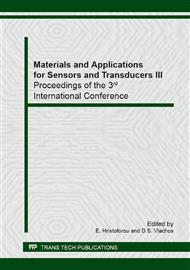p.1
p.7
p.11
p.15
p.19
p.23
p.27
p.31
Zinc Oxide Doped Red Sea Egyptian Clay as a Varistor
Abstract:
Clay consists of about 50% SiO2 + 25% Al2O3 plus some other oxides with low abundance ratio like CaO, TiO2, Fe2O3, MgO and Mn2O3. Burning the clay at 700°C removes out the organic compounds and the mentioned oxides only remain. Our aim is to dope ZnO by the remaining oxides for varistors fabrication. Six types of clay were collected from Egyptian Red Sea Coast mines, after burning for 2 hrs the remaining oxides were mixed and ball milled with ZnO for 10 hrs according to the formula (100-Xn) ZnO +Xn, where n is the clay type and X is the ratio of the clay in grams, X takes the values 0.525 in 15 steps. Samples were pressed and sintered at three different temperatures (Tsin) 1200°C, 1300°C and 1400°C for 1 hr, and then studied via XRD, SEM, EDAX, J-E and C-V measurements. The obtained results were discussed in terms of the microstructure of the samples and the formation of Schottky barriers. Barrier height Ф, width W, interface state density Ns and donor state density Nd were calculated for the samples with highest nonlinearity α. It was found that the breakdown electric field Eo is related exponentially with the ratio of Zinc silicate phase whereas α scales with ratio of ZnO phase and the later increases linearly with Tsin. The electrical characteristics of the most promising sample were compared with those of ZnO samples doped pure SiO2 and Al2O3 obtained at the same preparation condition. This sample is comparable with the Japanese commercial varistor 5N220k Dc JVR.
Info:
Periodical:
Pages:
7-10
Citation:
Online since:
April 2014
Authors:
Keywords:
Price:
Сopyright:
© 2014 Trans Tech Publications Ltd. All Rights Reserved
Share:
Citation:


